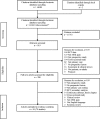Generic prognostic factors for musculoskeletal pain in primary care: a systematic review
- PMID: 28096253
- PMCID: PMC5253570
- DOI: 10.1136/bmjopen-2016-012901
Generic prognostic factors for musculoskeletal pain in primary care: a systematic review
Abstract
Objectives: To summarise the evidence for generic prognostic factors across a range of musculoskeletal (MSK) conditions.
Setting: primary care.
Methods and outcomes: Comprehensive systematic literature review. MEDLINE, CINAHL, PsychINFO and EMBASE were searched for prospective cohort studies, based in primary care (search period-inception to December 2015). Studies were included if they reported on adults consulting with MSK conditions and provided data on associations between baseline characteristics (prognostic factors) and outcome. A prognostic factor was identified as generic when significantly associated with any outcome for 2 or more different MSK conditions. Evidence synthesis focused on consistency of findings and study quality.
Results: 14 682 citations were identified and 78 studies were included (involving more than 48 000 participants with 18 different outcome domains). 51 studies were on spinal pain/back pain/low back pain, 12 on neck/shoulder/arm pain, 3 on knee pain, 3 on hip pain and 9 on multisite pain/widespread pain. Total quality scores ranged from 5 to 14 (mean 11) and 65 studies (83%) scored 9 or more. Out of a total of 78 different prognostic factors for which data were provided, the following factors are considered to be generic prognostic factors for MSK conditions: widespread pain, high functional disability, somatisation, high pain intensity and presence of previous pain episodes. In addition, consistent evidence was found for use of pain medications not to be associated with outcome, suggesting that this factor is not a generic prognostic factor for MSK conditions.
Conclusions: This large review provides new evidence for generic prognostic factors for MSK conditions in primary care. Such factors include pain intensity, widespread pain, high functional disability, somatisation and movement restriction. This information can be used to screen and select patients for targeted treatment in clinical research as well as to inform the management of MSK conditions in primary care.
Keywords: PRIMARY CARE; Prognosis; Prognostic Factors; Systematic review.
Published by the BMJ Publishing Group Limited. For permission to use (where not already granted under a licence) please go to http://www.bmj.com/company/products-services/rights-and-licensing/.
Conflict of interest statement
Conflicts of Interest: None declared.
Figures
References
Publication types
MeSH terms
Grants and funding
LinkOut - more resources
Full Text Sources
Other Literature Sources

